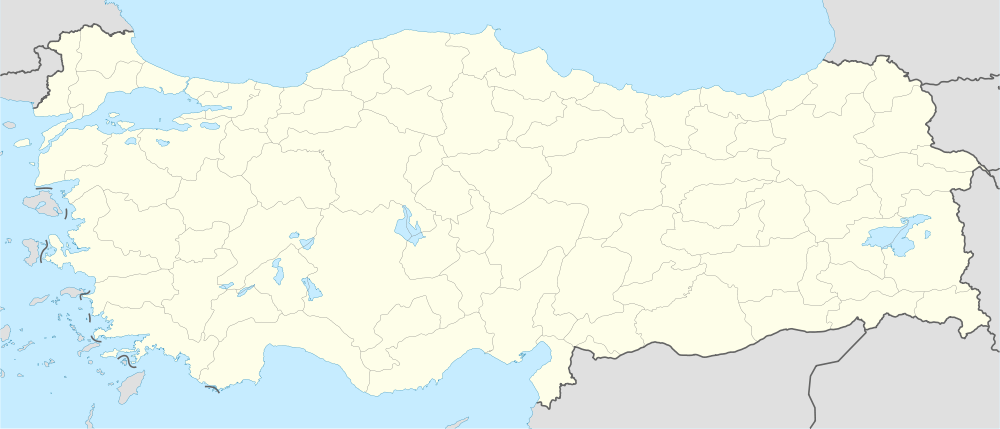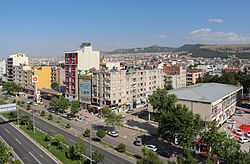Adıyaman
| Adıyaman | |
|---|---|
| Municipality | |
|
Atatürk Boulevard in Adiyaman | |
 Adıyaman | |
| Coordinates: 37°45′50″N 38°16′40″E / 37.76389°N 38.27778°ECoordinates: 37°45′50″N 38°16′40″E / 37.76389°N 38.27778°E | |
| Country | Turkey |
| Province | Adıyaman |
| Government | |
| • Mayor | Fehmi Hüsrev Kutlu (AKP) |
| Area[1] | |
| • District | 1,679.21 km2 (648.35 sq mi) |
| Population (2012)[2] | |
| • Urban | 217,463 |
| • District | 273,820 |
| • District density | 160/km2 (420/sq mi) |
| Website |
www |
Adıyaman is a city in southeastern Turkey, capital of the Adıyaman Province. It is one of the fastest-growing cities in Turkey. The population rose from 100,045 (1990) to 202,735 [3] (2010 census figures).
Etymology
The city officially had the name Hısn-ı Mansur ("Castle of Mansur") until the year 1926, named after the fortified castle perched on a hill around which the city grew. As this name was difficult for the locals to pronounce, people were referring the city as adı yaman, which means "its name is tough" or "(the place) whose name is tough" in Turkish. In 1926, this term was adopted as the official name of the city. In present-day Turkish, the word yaman can also have a strong positive connotation, just like the English word 'terrific'.
Climate
Adıyaman has a Mediterranean climate with some continental characteristics. Summers are very hot and very dry. Temperatures reach 40 °C (104.0 °F) at the height of summer for the majority of the time. The highest recorded temperature was 45.3 °C (113.5 °F) on 30 July 2000. Winters in Adıyaman are cool/cold and quite often snowy. The lowest recorded temperature was −14.4 °C (6.1 °F) on 24 January 1972.
| Climate data for Adıyaman (1960-2012) | |||||||||||||
|---|---|---|---|---|---|---|---|---|---|---|---|---|---|
| Month | Jan | Feb | Mar | Apr | May | Jun | Jul | Aug | Sep | Oct | Nov | Dec | Year |
| Average high °C (°F) | 8.5 (47.3) |
10.0 (50) |
14.8 (58.6) |
20.4 (68.7) |
26.4 (79.5) |
33.1 (91.6) |
37.7 (99.9) |
37.5 (99.5) |
32.9 (91.2) |
25.5 (77.9) |
17.0 (62.6) |
10.6 (51.1) |
22.87 (73.16) |
| Daily mean °C (°F) | 4.5 (40.1) |
5.7 (42.3) |
9.9 (49.8) |
15.0 (59) |
20.6 (69.1) |
26.8 (80.2) |
31.0 (87.8) |
30.5 (86.9) |
25.7 (78.3) |
18.9 (66) |
11.6 (52.9) |
6.5 (43.7) |
17.22 (63.01) |
| Average low °C (°F) | 1.2 (34.2) |
2.1 (35.8) |
5.4 (41.7) |
9.8 (49.6) |
14.2 (57.6) |
19.6 (67.3) |
23.6 (74.5) |
23.2 (73.8) |
18.8 (65.8) |
13.5 (56.3) |
7.4 (45.3) |
3.2 (37.8) |
11.83 (53.31) |
| Average precipitation mm (inches) | 133.9 (5.272) |
102.8 (4.047) |
89.6 (3.528) |
66.0 (2.598) |
40.4 (1.591) |
7.4 (0.291) |
1.0 (0.039) |
0.7 (0.028) |
5.1 (0.201) |
44.5 (1.752) |
75.6 (2.976) |
140.3 (5.524) |
707.3 (27.847) |
| Avg. rainy days | 11.7 | 11.9 | 12.0 | 11.9 | 8.0 | 2.5 | 0.6 | 0.5 | 1.3 | 6.5 | 9.1 | 11.5 | 87.5 |
| Mean monthly sunshine hours | 130.2 | 131.6 | 186.0 | 225.0 | 303.8 | 363.0 | 390.6 | 365.8 | 306.0 | 232.5 | 168.0 | 130.2 | 2,932.7 |
| Source: Devlet Meteoroloji İşleri Genel Müdürlüğü [4] | |||||||||||||
History

The area has been inhabited as far back as it's possible to discover. Research in the cave of Palanlı 10 km north of Adıyaman show occupation in 40,000 BC and other digs in Samsat reveal continuous occupation through the stone and Bronze Ages.
From 900BC onwards came waves of invasions from Assyrians, Persians, and Macedonians until the Commagene kingdom was founded in 69BC. This was the civilisation that built the statues on top of nearby Mount Nemrut. The capital was in Samsat (Samosata) but the town of Adıyaman was a walled city of the Commagenes. The city walls of Adıyaman have been restored and replaced many times since.
The Commagene kingdom lasted until the Romans came in 72AD. Yet more campaigns and invasions followed and Adıyaman was controlled by Byzantines 395-670, Ummayads from 670 and then Abbasids 758-926. Then the area returned to Byzantine control during 859-1114. The Arabs returned from 1114 to 1204 and finally came the arrival of the Turks. The Arabic name for the castle and town was Hısn-ı Mansur.
Turks moved into the area from 1114 onwards and for most of the 13th century was settled by the Selçuk Turks often disrupted by Mongol invasions. From 1298 to 1516 the town was under the control of the Mameluks. Adıyaman was brought into the Ottoman Empire by Selim I in 1516, but local power often rested with the Dulkadiroğulları tribe of Turkmen people that settled here.
Adıyaman today
The city of Adıyaman provides shops and infrastructure to an agricultural region watered by the River Euphrates. It is not an industrial city, people riding mules and donkeys are still a common sight. The Atatürk reservoir is near the city and with more investment in irrigation, this could become a richer agricultural zone. Although Adiyaman still has a lot of conservative people, it is easy to find a place that sells liquor. The cuisine is typical of south-east Turkey, including dishes like çiğ köfte and Maraş-style ice-cream.
The city is served by Adıyaman Airport.
Adıyamanspor is a minor league football team.
Places of interest
.jpg)
There is some passing tourist trade, the main tourist attraction being Mount Nemrut.
- The caves of Pirin (ancient city of Perre) are 5 km (3 mi). from Adiyaman. These have been used as a burial ground for thousands of years. The sights include the ruins of the city and burial caves carved into the rock.
- Further tourist information is available at the Southeastern Anatolian Promotion Project site.
The ancient city of Arsemia, the summer retreat of the Kingdom of Commagene, can also be visited.
Adiyaman is one of the fastest developing cities in Turkey, with many cafes, cinemas and shopping centers.
See also
References
- ↑ "Area of regions (including lakes), km²". Regional Statistics Database. Turkish Statistical Institute. 2002. Retrieved 2013-03-05.
- ↑ "Population of province/district centers and towns/villages by districts - 2012". Address Based Population Registration System (ABPRS) Database. Turkish Statistical Institute. Retrieved 2013-02-27.
- ↑
- ↑ MGM
- Richard Talbert, Barrington Atlas of the Greek and Roman World, (ISBN 0-691-03169-X), p. 67.
External links
| Wikivoyage has a travel guide for Adiyaman. |

